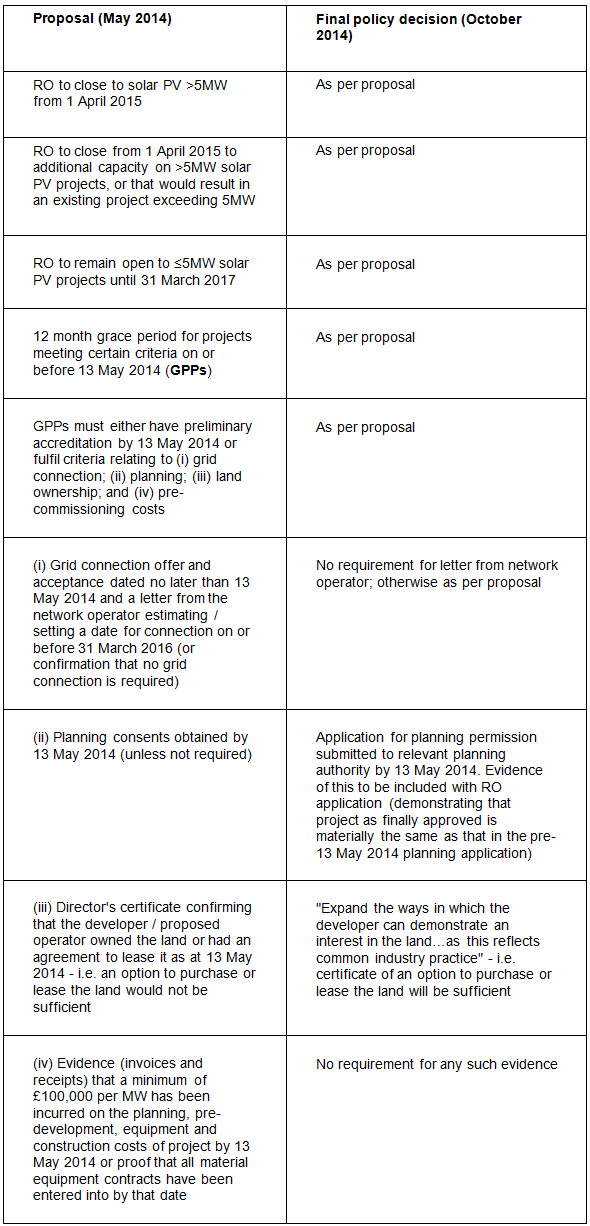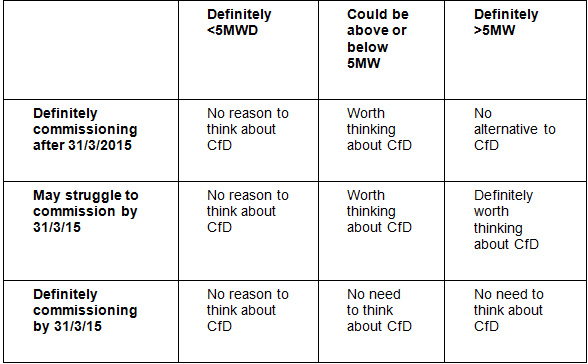Following a consultation that ran from 13 May to 7 July 2014, the UK Government has confirmed its intention that, as a general rule, funding under the Renewables Obligation will not be available to larger scale (>5MW solar) PV projects after 31 March 2015.
There will be a “grace period” of a year for projects which were, in effect, in a position to begin development before 13 May 2014. Perhaps more usefully for projects which may struggle to meet the requirements for RO accreditation before 31 March 2015, further consultation is taking place on a proposal to protect the position of those projects which only fail to meet the 31 March 2015 cut-off date for commissioning because their electricity network operator has not met a pre-31 March 2015 estimated connection date.
Background
For most technologies, the Renewables Obligation will close on 31 March 2017. After that date, smaller projects will have to rely on the Feed-in Tariffs regime and larger projects must compete for Contracts for Difference (CfDs) under Electricity Market Reform. In March 2014, the Government set out its overall approach to the two and a half year transition period when both the RO and CfD regimes are open to new projects: developers are able to choose between the two schemes (subject to certain qualifications). But subsequently DECC has become increasingly concerned that the rapid growth of the UK solar industry, supported by the “demand-led” RO, will breach the Levy Control Framework (LCF) limits on the overall amount of money that the Treasury will permit to be spent on renewable energy subsidies. In its May 2014 consultation, DECC estimated that large-scale solar PV deployment under the RO could reach “more than 5GW by 2017”; in the response to that consultation, DECC’s “updated assessment” found that “in the absence of intervention”, up to 10GW of solar PV could deploy within this period, costing some £400m more than was allowed for in the EMR Delivery Plan and exceeding the LCF cap.
Proposals and policy decisions
The table below summarises the Government’s main proposals on RO closure for solar PV in the May consultation and the policy decisions announced in the response to consultation.
DECC has not been persuaded to change the cut-off date or open up the grace period to a wider group of projects. Responding to “the main criticism…that any projects that can meet the grace period…requirements are unlikely to need the grace period because they will already be sufficiently advanced to secure connection by 31 March 2015”, DECC states that “the grace period will have fulfilled its purpose if it protects eligible projects that subsequently encounter unexpected events which delay their completion beyond the end of March 2015. However, DECC very clearly has taken on board the industry’s practical objections around the evidence to be provided by those that are eligible for the grace period and has accommodated its evidential requirements to the realities of the industry.
Further consultation
In response to comments from consultees that early closure of the RO to large-scale solar would create a “cliff-edge” effect for some projects, DECC has put out a further consultation (closing on 24 October 2014) on the proposal that there should be a separate 3 month grace period (until 30 June 2015) for projects which are prevented from meeting the 31 March 2015 deadline only because they are not connected to the grid by that date.
The proposal is that such projects would have to include in their RO application:
- a grid connection offer and acceptance and a letter from the network operator estimating or setting a date for connection of no later to 31 March 2015 (the estimated connection date);
- a declaration by the developer that to the best of its knowledge, the project would have been commissioned by 31 March 2015 if the connection had been made by the estimated connection date; and
- a letter from the network operator confirming that in its opinion, the failure to make the grid connection before the estimated connection date was not due to any failure on the part of the developer.
The first of these proposed requirements is open to the same sorts of objections that were made by the industry against the proposed requirement for a letter from the network operator that formed part of the May 2014 proposals. However, DECC insists that past experience on banding review grace periods suggests that the difficulties associated with it are “not insurmountable”, and the response to consultation is careful to note that the requirement has been removed from the final policy decision on the May proposals because a letter from the network operator was considered unnecessary in that context, rather than that it would be too difficult to obtain.
What next?
DECC intends to implement the policy decisions described above in relation to RO closure through an amendment to the Renewables Obligation Closure Order 2014, to take effect on 1 April 2015.
DECC is evidently determined to do whatever it has to in order to mitigate the risk that the growth in large-scale solar PV will lead to a breach in the Levy Control Framework limits. It wants the sector to switch to the CfD regime, where the auction-based allocation process will drive down the costs of subsidy, acknowledging that the greater complexity of the CfD regime will favour the larger players in the industry.
The deadline for applications for the first CfD round is now 30 October 2014, and in recent publications both DECC and National Grid (as EMR Delivery Body) have been doing their best to make the regime user-friendly. The table below suggests which groups of developers may need to consider making a CfD application. If onshore wind developers (with whom solar projects must compete) are likely to avoid bidding for CfDs in the first auction since they have until 31 March 2017 to achieve RO accreditation, it may be that solar projects stand a reasonable chance of success of being allocated CfDs later this year.
At present, for those who miss out on both the RO and a CfD from the first allocation round, the next opportunity would be a CfD allocation round in Autumn 2015. DECC has given some indications that it is sympathetic to the proposition that the rapid development cycle of solar projects means that there ought to be solar CfD allocations every 6 months rather than every year, as for other technologies, but it also points out that more frequent auctions would not mean any increase in the overall budget. And since 2015 is a General Election year, no promises of a further allocation round for solar can be made at present.



